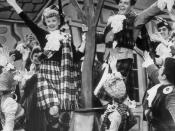The show heralded as the first romantic sitcom, I Love Lucy, premiered October 15, 1951 (Ross). It featured a dull-witted, but beautiful and funny Lucille Ball starring opposite the intelligent and ever charming Desi Arnaz. The show highlights women as irrational, feeble-minded beauties, incapable of self-sufficiency and unable to perform basic tasks of everyday life. Things have changed since then. Women have risen out of the home and entered the working world at full force. Consequently, the representation of women in contemporary romantic sitcoms should be different. Women should be outraged if they are portrayed like Lucy. That is why The Newlyweds starring Jessica Simpson and Nick Lachey is coming back for its fourth season (MTV Networks). That is why the largest demographic watching that show is supposedly liberated high school and college-aged women (All Your TV).
In many ways, I Love Lucy and The Newlyweds is the same show.
They both draw their fan base by the humor invoked by the gorgeous young woman acting absolutely ridiculous. They employ the gendered stereotypes of the brainless bimbo being cared for by her calm confident husband. One episode of I Love Lucy exhibits the couple chatting about an accumulating pile of bills (TV Land). When Ricky begins to fret over the situation, Lucy demonstrates her competence by spinning the Lazy Susan upon which the bills lay, paying only the survivors. Ricky simply laughs at her, dismissing her foolish financial tomfoolery as something beyond the grasp of a woman's understanding. His response is illustrative of the stereotypical male. Similarly, on The Newlyweds, Jessica becomes confused about the statement "Chicken of the Sea," that is located on her can on tuna. She becomes confused and asks, "Is this chicken or fish?" Nick responds calmly, explaining this puzzle to his beautifully baffled bride...


